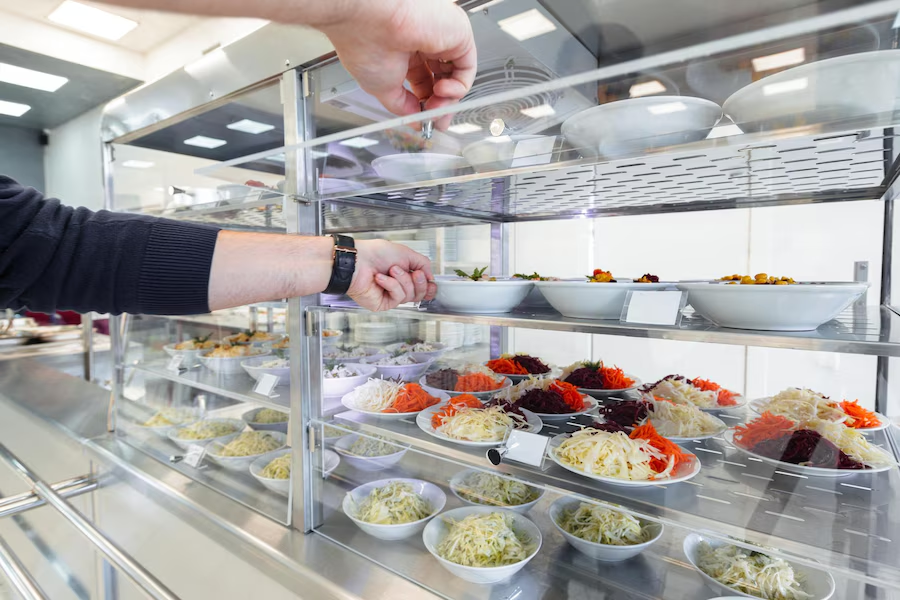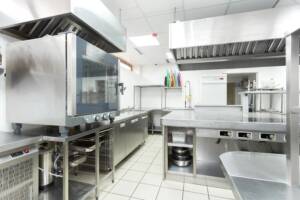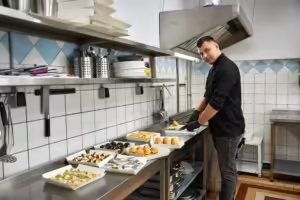
In the world of food and restaurant industry, efficiency, speed, and food quality have become critical factors that greatly affect the success of any restaurant. Among the modern solutions that have radically changed the shape of the industry, the central kitchen in restaurants stands out as one of the distinctive innovations that contribute to improving operations and saving costs, while ensuring a distinguished dining experience for customers. But what is the central kitchen? And how can it make a big difference in the workflow within restaurants?
In this article, we will learn together about the importance of the central kitchen in restaurants and its many benefits, in addition to how to apply it effectively to ensure food quality, speed of performance, and reduce costs. If you are a restaurant owner or thinking of developing your business in this field, continue reading to discover how this system can make a big difference in improving your performance.
What is the central kitchen in restaurants?
The central kitchen in restaurants is a facility dedicated to preparing and preparing food centrally, to be later distributed to the various branches or places that need it. This system relies on the use of modern technologies to prepare food in large quantities in one environment and then transport it to other places, such as branches or other sales sites.
The importance of the central kitchen in restaurants
Central kitchens in restaurants are essential for achieving many goals, such as:
1- Achieving uniformity in quality
The central kitchen helps ensure that the same quality and taste are provided in all branches of the restaurant, providing a uniform dining experience for customers anywhere.
2- Reducing costs
By consolidating preparation processes in one place, the restaurant can reduce costs associated with resources such as labor and food.
3- Increasing operational efficiency
The central kitchen facilitates coordination between various food operations, which leads to improved operational efficiency and reduced wasted time.
4- Better inventory management
The central kitchen in restaurants allows restaurants to better control inventory and use raw materials more effectively, reducing waste.
How does the central kitchen in restaurants work?
The central kitchen in restaurants includes several basic stages to ensure efficient operation. First, the basic ingredients are received and stored in an organized manner in central warehouses. After that, the food is carefully prepared and prepared using modern machines and equipment. Finally, the food is transported to other branches or locations that will serve it to customers.
Advantages of a central kitchen in restaurants
1- Improved quality control
By having one central kitchen, all processes can be monitored and the necessary checks can be carried out to ensure that quality standards are met at all times.
2- Expand easily
The central kitchen helps restaurants expand quickly, as production can be easily increased without the need to open new kitchens in each branch.
3- Quick response to demand
When large orders occur, the central kitchen can meet needs more quickly compared to traditional kitchens in branches.
4- Improved organization
The central kitchen contributes to improving organization in general, from preparing food to transporting it to different branches, which reduces the chances of human error.
Should all restaurants adopt the central kitchen system?
Not every restaurant needs a central kitchen in restaurants. This depends on the size of the restaurant, the number of branches, and the type of food served. For example, large restaurants with many branches may find that a central kitchen in restaurants is the ideal solution for increasing productivity and ensuring consistency in quality. While small restaurants or those serving complex dishes in a local style may prefer to focus on individual operations.
How to Successfully Implement a Central Kitchen in Restaurants
1- Comprehensive Feasibility Study
Before starting to establish a central kitchen in restaurants, a comprehensive feasibility study must be conducted to ensure that this step will be economically feasible. This includes calculating initial costs, such as purchasing equipment, building appropriate spaces, and hiring a work team. Market needs must also be studied, and understanding how to manage production and distribution processes efficiently to ensure that food is served with the same quality in all restaurant branches.
2- Choosing the right location for the central kitchen
Choosing the location of the central kitchen in restaurants is a crucial step. The location must be in a place that is easily accessible from all restaurant branches or targeted locations. It can be near main areas or in industrial sites that provide ease of transportation and distribution. Sufficient space must also be provided to accommodate production lines, storage, and modern equipment to ensure smooth workflow.
3- Taking advantage of the latest technologies
One of the most important features of a central kitchen in restaurants is the use of advanced technology to improve efficiency and production quality. By using kitchen management software and temperature control systems, workflow can be greatly improved. An inventory tracking system can also help ensure that the necessary ingredients are available at all times, reducing waste and improving costs.
The role of the central kitchen in improving the customer experience
1- Accelerating the pace of service
By implementing the central kitchen in restaurants, the speed of serving food can be improved in all branches. After preparing food in the central kitchen, it is distributed faster and more efficiently to different restaurants, reducing waiting time for customers. This speed does not affect quality, but rather contributes to enhancing the customer experience, especially in restaurants that rely on express delivery service or serving food during peak times.
2- Unifying the food experience
When using the central kitchen in restaurants, it can be ensured that each branch provides the same quality and flavor, which enhances the customer experience and increases their loyalty. Regardless of the geographical location, customers in all branches will receive the same delicious food they expect, which enhances the restaurant’s reputation and gives it a strong competitive advantage.
3- Sustainable expansion
If you are thinking of expanding your restaurant network or want to open new branches, the central kitchen is the ideal solution. Through this system, you can open new branches more easily, without having to invest in building new kitchens in each location. Growth in this case depends on your ability to manage the central kitchen efficiently, allowing you to expand your business sustainably.
The impact of the central kitchen on environmental sustainability
1- Reducing waste
The central kitchen in restaurants contributes significantly to reducing waste. By managing inventory in a more organized way, over-purchase of raw materials or improper storage can be avoided. Preparing food in larger quantities in one place also helps reduce waste resulting from unused food in distributed kitchens.
2- Use resources more efficiently
The central kitchen can further optimize the use of resources such as electricity, water, and gas by managing operations in one location. Strategies such as using energy-efficient equipment can be implemented, which reduces the overall environmental impact of the restaurant.
The central kitchen in restaurants as an ideal solution for global restaurant chains
1- Supporting global expansion
If you are a multi-branch restaurant owner or are thinking of expanding into new markets, the central kitchen in restaurants is the ideal solution to support this expansion. By adopting the central kitchen model, the restaurant can centrally manage production and organize the distribution of food to different markets effectively, allowing you to open new branches in various locations without the need for a large investment in kitchen equipment in each branch.
2- World-class Operations Management
When running a global restaurant chain, you need to ensure that the same quality standards are met across all branches. A central restaurant kitchen helps achieve this by standardizing the food preparation process, making it easier to manage operations across markets. It also helps provide a consistent menu across all branches of the chain, ensuring that customers will always have the same experience wherever they are.
In conclusion, the central kitchen in restaurants is the ideal solution to improve efficiency, reduce costs, and ensure food quality across all branches. If you are considering implementing this model in your restaurant or are looking to improve your performance, ProNano Food Industry Consulting Company offers you the ideal solutions. The company provides specialized consultations in the design and construction of the central kitchen in restaurants, as well as improving operational processes and developing distribution strategies. Contact ProNano Company now to get the support and expertise needed to achieve the success of your restaurant using this advanced system.
Read more about the central kitchen in hospitals



